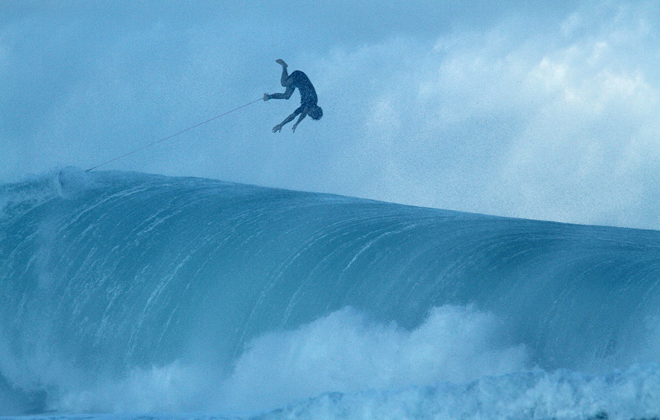Oahu beach closed due to high surf warning

A surfer went head over heels in high surf at the Banzai Pipeline early Wednesday morning.
The state Department of Land and Natural Resources closed the Keawaula beach section of Kaena Point State Park on Tuesday afternoon due to high surf.
The beach will remain closed Tuesday night to Wednesday until high surf subsides and lifeguards give the all-clear. State parks officials will assess surf condition on Hawaii island Wednesday morning to determine whether any of its beach parks should be closed for safety concerns.
The National Weather Service is warning of “dangerously large surf” expected to bring 30- to 40-foot waves to north and west shores and elevated surf to south shores not normally affected by winter swells.
A high surf warning is in effect from 6 p.m. Tuesday through 6 p.m. Thursday for north and west shores of Oahu, Kauai County, Maui, Molokai and west shores of the Big Island.
Forecasters expect the swell to begin arriving late Tuesday night and peak Wednesday afternoon with surf heights of 30- to 40-feet on north and west shores o f Niihau and Kauai and north shores of Oahu, Molokai and Maui. West shores of Oahu and Molokai will see 15- to 20-foot wave faces. The Big Island can expect 15- to 20-foot surf along west shores.
Forecasters also expect a west-northwest swell building rapidly Tuesday night, which will bring dangerously large surf to many areas that are not normally affected by witner wells, including west facing shore of Lanai and the Big Island.
Don't miss out on what's happening!
Stay in touch with breaking news, as it happens, conveniently in your email inbox. It's FREE!
A high surf advisory is also posted for south shores of Oahu and west shores of Maui, Lanai and Kahoolawe because of the unusual westerly component of the swell.
Waves could reach 12- to 15-feet on west shores of Maui and 6- to 10-feet along south shores of Oahu, and west shores of Lanai and Kahoolawe.
The north and west shore surf could bring “extreme” conditions with “ocean water surging and sweeping over beaches, coastal benches, lava flows and roadways creating the potential for significant impacts to coastal properties and infrastructure, including roadways,” forecasters said in a warning message.
“Large breaking surf, significant shorebreak and dangerous currents make entering the water extremely hazardous. Anyone entering the water could face significant injury or death. Inexperienced persons should remain off beaches and adjacent beachfront areas,” the National Weather Service said.
Despite the size of the surf, organizers of the Quiksilver in Memory of Eddie Aikau big wave contest said the waves will not be consistent enough or last long enough to hold the invitation-only surf competition.
The one-day big wave event was last held on Oahu’s North Shore on Dec. 8, 2009, and has only been held a total of eight times in its history. It is only held when wave heights and surf conditions meet contest standards.
The holding period for the contest runs until the end of February.
“After assessing all available forecast sources, we are not seeing sufficient energy to run the event this week,” said Event Director Glen Moncata. “The Quiksilver In Memory of Eddie Aikau requires a full eight-hour day of waves with minimum 40-foot faces. What we are seeing simply does not meet the criteria. Yes, there will be some waves of that height in the latter half of the day, but not a full day of consistent surf. We will wait.”



